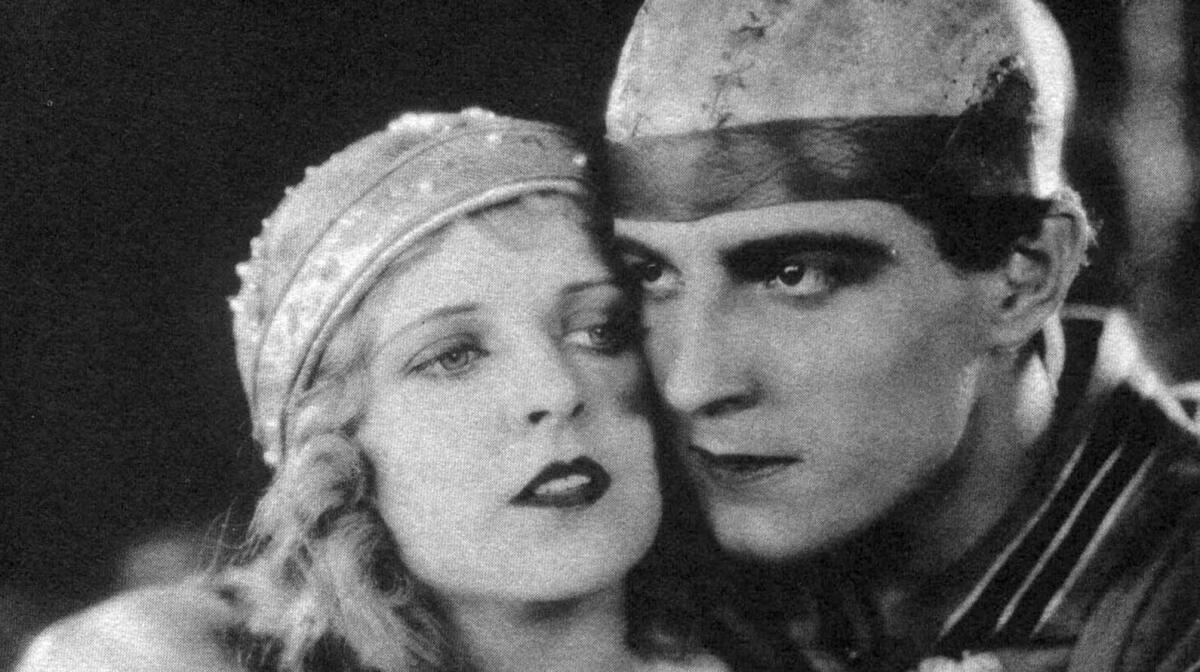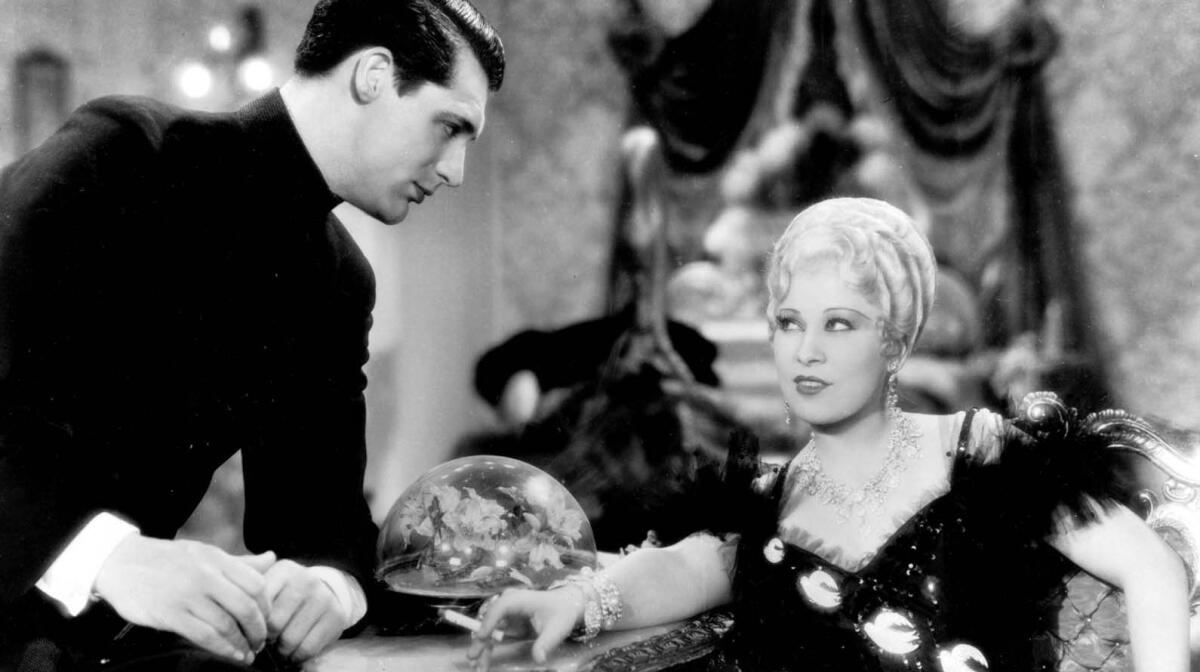Newsletter: Classic Hollywood: Maureen O’Hara, Joan Crawford and Mae West
- Share via
T
his is Susan King, a 25-year veteran of the Los Angeles Times and guardian of the Golden Age of Hollywood galaxy. Every Friday in my Classic Hollywood newsletter, I wax nostalgic on notable birthdays, deaths, the latest in oldies on DVD, vintage-themed books, fun events around town and memories of the legends I have had the fortune to interview during my career.
Like Maureen O’Hara, who died Oct. 24 at 95. I had the great opportunity to interview her twice -- for a 1995 CBS holiday film “The Christmas Box” and the 2000 CBS movie “The Last Dance,” which would be her last film. She was 80 years young when I interviewed her in 2000 and still possessed the same gorgeous red hair, blue eyes and peaches-and-cream complexion that made her the Queen of Technicolor in such films as 1942’s “The Black Swan” and John Ford’s 1952 classic, “The Quiet Man,” with John Wayne.

Maureen O’Hara and John Wayne star in director John Ford’s 1952 release of “The Quiet Man.”
Maureen O'Hara and John Wayne star in director John Ford's 1952 release of "The Quiet Man." (Artisan Home Entertainment)
She said she and Wayne engaged in a handshake agreement with Ford in 1944 to make “The Quiet Man.”
“It took from '44 to '51 to get the money,” she told me. “We made ‘Rio Grande’ to raise the money to make ‘The Quiet Man.’ The studios thought it was such a silly little Irish story and it would never make a penny. And Duke said, ‘Let’s please send it to old man [Herbert] Yates at Republic Pictures. That [studio] was a step down for Ford.”
And Yates, who was the studio head at Republic, shared the same view. But he added, “If the same outfit -- the same producers, actors and director -- made a western for me to recoup the money I am going to lose on ‘The Quiet Man,’ then I’ll finance it."
On Friday, TCM is paying tribute to O’Hara with 24 hours' worth of her features, including 1963’s “McLintock!” with Wayne; 1971’s “Big Jake,” her last film with Wayne; 1939’s “The Hunchback of Notre Dame”; 1947’s “Sinbad the Sailor” and “The Quiet Man.”
Around town
On Saturday afternoon, the American Cinematheque’s Egyptian Theatre in Hollywood is presenting the Art Deco Society lecture “Art Deco Dreams: The History of Fashion in Film 1925-1935” with film and fashion historian Kimberly Truhler. The lecture is followed by the yummy 1928 “Our Dancing Daughters,” which made Joan Crawford a star as a good-hearted flapper. It was the first time Crawford's name appeared before the title. John Mack Brown plays a millionaire, and Anita Page is nothing but a gold digger. The silent film features some music and sound effects. This is definitely a jumbo-box-of-popcorn flick.
DVD vaults
Warner Archive is shining the spotlight on the career of Ramon Novarro, a.k.a. the Latin Lover, who came to fame during the silent era at MGM in such films as 1925’s “Ben-Hur: A Tale of Christ.” The Mexican-born actor continued to work when talkies arrived. I always found his performances in silents such as “Ben-Hur” strong and memorably affecting, but he seemed uncomfortable performing in talkies. His accent was strong and the studio just didn’t seem to know what to do with him. His career did a slow but steady fade, and he left MGM in 1935.

Ramon Novarro and May McAvoy in “Ben-Hur: A Tale of Christ.”
Ramon Novarro and May McAvoy in "Ben-Hur: A Tale of Christ." (Silent Movie Theatre)
Warner Archive is bringing out seven of his talkies, which have all been newly remastered: the 1929 musical “Devil May Care”; the 1930 musical comedy “In Gay Madrid”; the 1931 drama “Daybreak”; the 1931 adventure romance “Son of India”; 1932’s “The Son-Daughter,” in which Novarro and Helen Hayes play Chinese lovers living in San Francisco; 1934’s “Laughing Boy,” in which he stars as a Navajo; and his final MGM film, the 1935 musical “The Night Is Young,” which also features a young Rosalind Russell.
Book nook
Daniel de Visé, a journalist/author who has worked at the Washington Post and Miami Herald and was the brother-in-law of Don Knotts, has penned the new book “Andy & Don,” a chronicle of the five-decade friendship between Knotts and Andy Griffith. In 1955, the two appeared together on Broadway in the hit play “No Time for Sergeants,” going on to do the 1958 film version of the comedy. They then starred together in the classic 1960s CBS comedy series “The Andy Griffith Show,” for which Knotts received five Emmys as Deputy Barney Fife. Though Knotts left the series as a regular in 1965, they remained closed friends until Knotts’ death in 2006.
Sneak peek
During the Golden Age of Hollywood, stars and starlets posed for publicity photos, including holiday portraits. In this Sunday’s Classic Hollywood, I chat with film historians Karie Bible and Mary Mallory about their fun new book “Hollywood Celebrates the Holidays: 1920-1970."
From the Hollywood Star Walk
Notable births this week include Eleanor Powell (Nov. 21); Marlo Thomas (Nov. 21); Hoagy Carmichael (Nov. 22); Rodney Dangerfield (Nov. 22); Jamie Lee Curtis (Nov. 22); Robert Vaughn (Nov. 22); Boris Karloff (Nov. 23); Victor Jory (Nov. 23); Howard Duff (Nov. 24); Geraldine Fitzgerald (Nov. 24); and Ricardo Montalban (Nov. 25).
Come up and see me sometime!

Cary Grant and Mae West in Lowell Sherman’s “She Done Him Wrong.”
Cary Grant and Mae West in Lowell Sherman's "She Done Him Wrong." (UCLA Film & Television Archive)
Sunday marks the 35th anniversary of the death of Mae West, the shapely platinum blond who brought her risqué sense of humor to the stage and movies. She excelled during the pre-Hollywood Production Code area of the early 1930s when her unabashed sexuality made her one of biggest box-office draws of the era, thanks to 1933’s “She Done Him Wrong,” which earned a best-picture Oscar nomination, and “I’m No Angel.” Both films also starred a young Cary Grant. But her career suffered when the code cracked down on sexuality in films. West made one more classic, 1940’s “My Little Chickadee” with W.C. Fields. Here is the L.A. Times obituary of West as it appeared on Nov. 23, 1980.
For more vintage Hollywood, go to the Classic Hollywood Los Angeles Times Facebook page and follow me on Twitter at @mymackie.
Only good movies
Get the Indie Focus newsletter, Mark Olsen's weekly guide to the world of cinema.
You may occasionally receive promotional content from the Los Angeles Times.








